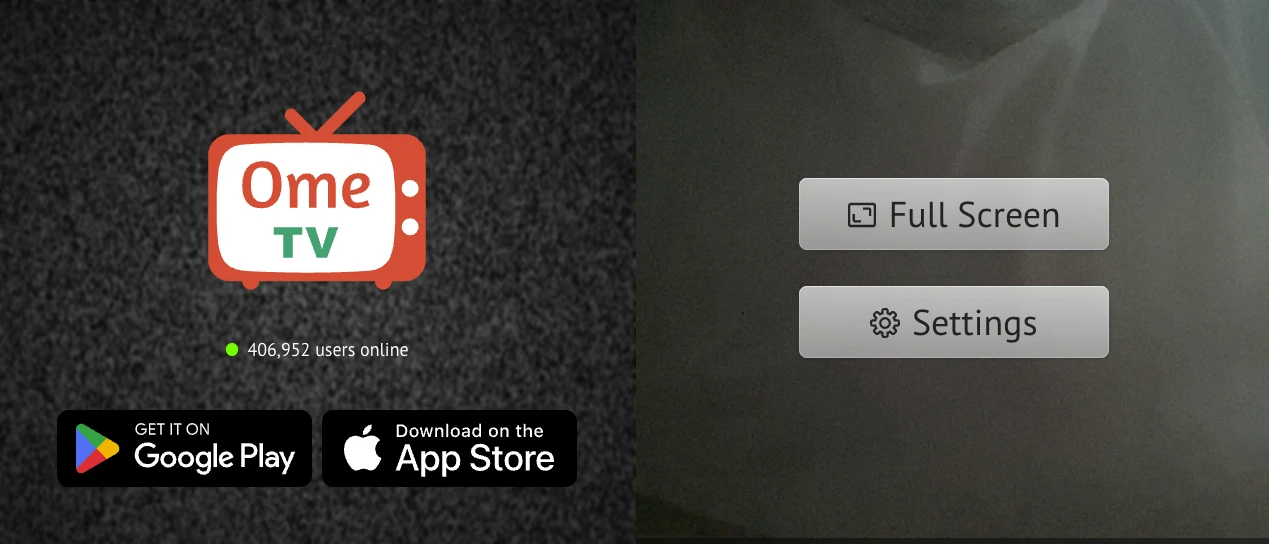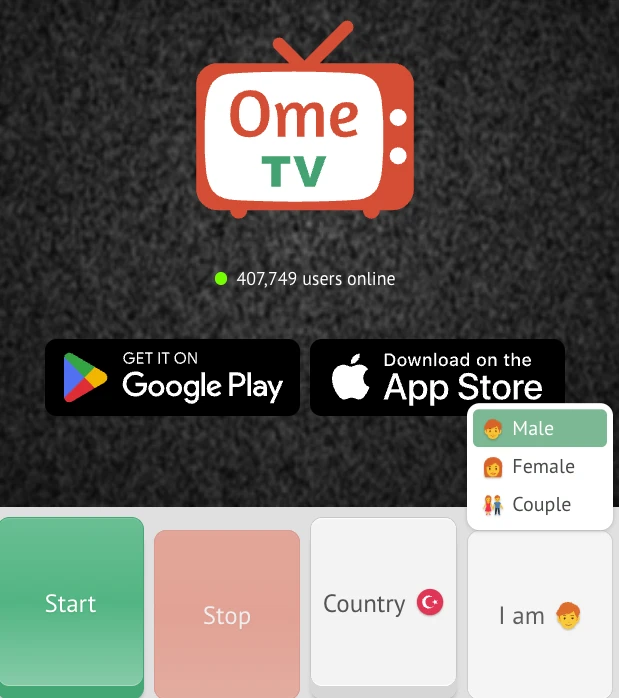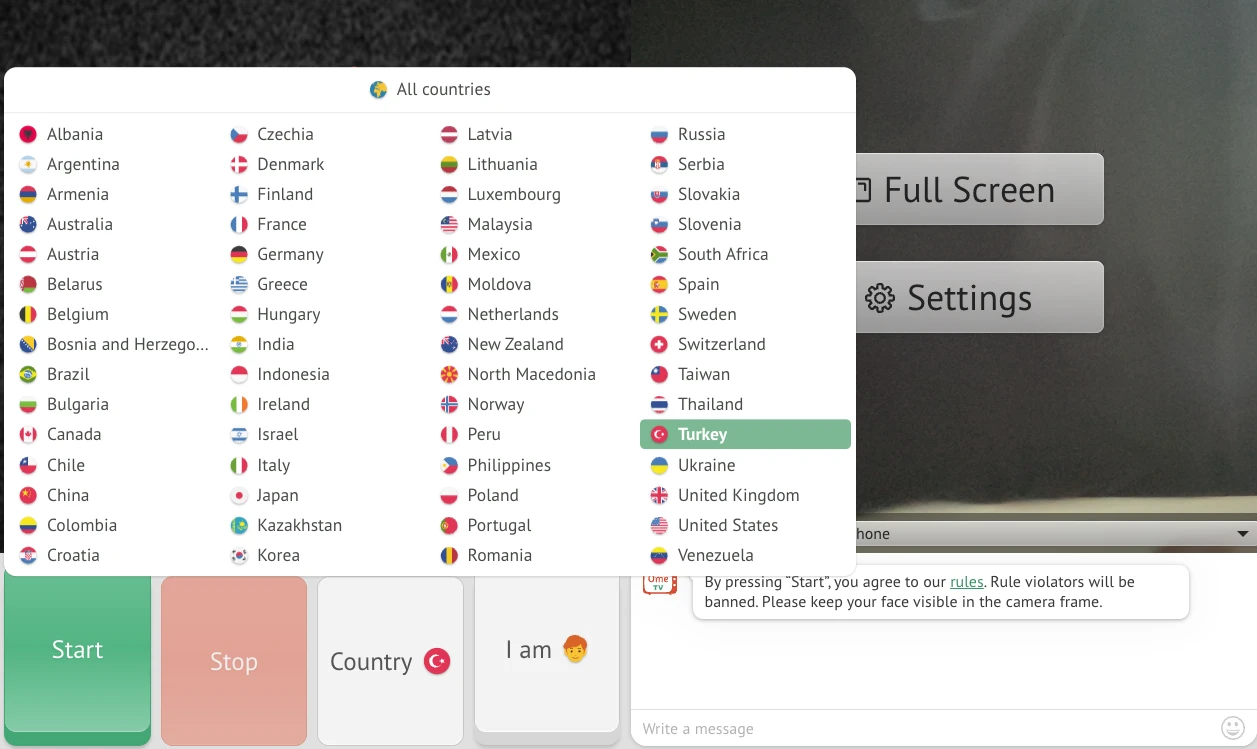OmeTV: Meet Real People Instantly in 1 on 1 Video Chats

What Is OmeTV and How Does It Set Itself Apart
OmeTV is a random video chat platform that connects strangers for real-time conversations. At first glance, it appears similar to other sites in the same space, but several design choices set it apart. The platform does not require account creation. You open the site or app, enable camera access, and the system pairs you with someone new.
The key difference is the way OmeTV positions itself. Unlike platforms that encourage flirting or adult content, OmeTV presents a more neutral environment. The visual layout is simple, with clean menus and no distracting graphics. It promotes itself as a safe, ad-free space for talking to new people. The absence of banners or promotional overlays supports this image.
OmeTV also avoids using interest-based matching. Instead of letting users list hobbies or keywords, it relies on location and connection speed. The randomness remains intact, but it feels more refined. The pairings happen fast, and the system moves you to the next person without delay.
Another unique aspect is the way the platform presents interaction. There is no private messaging system or follow-up options. Once a session ends, the connection disappears. This structure encourages short, anonymous conversations with no ongoing contact. It reduces the risk of stalking or harassment and supports a lighter form of engagement.
While many competitors blur the line between social interaction and content monetization, OmeTV keeps its structure consistent. There are no profile customizations, no tipping systems, and no public leaderboards. It does not try to turn chat into entertainment. It remains focused on short, unpredictable communication between strangers.

Is OmeTV Really Free to Use or Just Freemium in Disguise
OmeTV promotes itself as a free platform, and that claim is technically accurate. You can visit the site or download the app, activate your camera, and start chatting with random users without paying. There is no subscription wall at the start. You do not need to enter payment information to access the core feature, which is real-time video pairing.
However, free access comes with limitations. On mobile devices, especially within the iOS and Android apps, certain options are locked unless you upgrade. This includes choosing the gender of the person you want to match with. On the website, this feature is not available at all. In both cases, the system defaults to completely random pairings unless a payment is made.
There are also cooldown periods for some users. If you skip too quickly or switch partners frequently, the app may slow down the matching process unless you purchase an add-on to remove the delay. While this does not block usage, it creates friction that encourages users to consider spending.
Basic interaction remains open. You can chat, leave, and return without cost. But the moment you want to apply filters or improve matching accuracy, the platform begins to introduce upgrade prompts.
What Paid Features Actually Unlock
The most visible paid feature on OmeTV is gender selection. By paying, users can choose to connect only with people of a specific gender. This filter is especially promoted in mobile apps. Without payment, all pairings are random and based only on who is currently online.
Another paid option involves cooldown bypass. If the system slows down your connection rate due to high activity, a one-time purchase can remove this limit. The app also includes small upgrades that reduce delays between chats or improve matching speed. These are often marketed as convenience tools rather than core requirements.
There is no token system or virtual gifting model. Payments are not linked to tipping or chat enhancements. Instead, the upgrades are practical. They improve control and pacing, not social impact or profile visibility.
OmeTV keeps its paid system separate from conversation. You cannot pay to be promoted or to reach more users. You can only pay to change how often and how specifically you connect. This distinction keeps the social space balanced but still places some key options behind a paywall.
Which Platforms Support OmeTV and How the Experience Differs on Web, iOS, and Android
| Feature | Web Version | iOS App | Android App |
|---|---|---|---|
| No Registration Required | Yes | Yes | Yes |
| Random Video Chat | Yes | Yes | Yes |
| Gender Filter | No | Yes (Paid) | Yes (Paid) |
| Country Filter | Yes | Yes | Yes |
| Ad-Free Interface | Yes | Yes | Yes |
| Paid Upgrades Available | No | Yes | Yes |
| Skip Delay Option | No | Yes (Paid) | Yes (Paid) |
| Instant Match Speed | Yes | Yes | Yes |
OmeTV can be accessed through three main platforms: its official website, the iOS app, and the Android app. While the core function of random video chatting remains consistent across all three, several features behave differently depending on the platform you use.
On the web version, you can start chatting without creating an account. The interface is clean, and there are no ads. You have access to country filters, which let you limit connections to specific regions. However, gender selection is not available. All matches are assigned randomly. There are no paid upgrade options on the web. Everything you see is part of the free experience, but with fewer controls.
The iOS app includes all basic features along with several premium ones. Users can select a preferred gender if they pay for the upgrade. Country filtering is available, and the app runs with the same ad-free structure. Some features, such as skip delay removal and enhanced match speed, are locked behind in-app purchases. The interface is slightly more compact due to mobile screen constraints, but the experience is smooth and accessible.
The Android app mirrors the iOS version in most ways. It supports gender and country filters, both visually and functionally. Paid options are presented as one-time upgrades or bundles. Just like on iOS, you can skip faster, filter your audience, and increase session speed if you pay. Some Android users report occasional connection issues, but the general structure is stable.
In short, if you want full access to all filters and pacing controls, the mobile apps offer more functionality than the web version. If you prefer no payments and are comfortable with fewer controls, the browser experience is simpler and completely open.
Core Features of OmeTV That Attract Millions
OmeTV has gained attention by offering a chat experience that feels immediate and open. While some features are visible on the surface, others shape the experience in ways that are less obvious. Below are several core components that define how the platform works beyond the basics.

Real-Time Text Translation During Video Chats
One of OmeTV’s most unique features is its built-in translation tool. During a video session, users can type messages that are automatically translated into the language of the other person. This allows people from different countries to communicate clearly without switching platforms or using third-party tools.
The translation happens instantly. When you type in your own language, the message appears in the chat box below the video feed, and the other person sees it in their local language. While it is not perfect, the system makes small talk, questions, and even light conversations possible between users who would otherwise struggle to connect.
This feature changes the entire tone of the platform. It removes the need to skip someone just because you do not share a common language. It also gives the impression that the platform encourages global connections rather than only local ones.
Session-Based Matching Without Tracking
Unlike platforms that try to create user profiles or track preferences, OmeTV resets the experience each time you visit. Every session starts from zero. The system does not remember who you talked to, what you said, or how you behaved. Each connection is temporary.
This design choice avoids the problem of building history-based filters or personality-based algorithms. Instead of trying to shape who you meet, OmeTV simply reacts to availability. You meet the next person in the queue without bias.
It also means there is no visible scoring system, reputation level, or status marker. Everyone enters as a blank profile. This encourages equal footing between users and reduces the pressure to perform or impress.
Automatic Moderation with Visual Detection
OmeTV uses a hybrid moderation system that includes both artificial intelligence and human oversight. What makes it different is the way the AI detects violations based on video content. The system does not rely solely on user reports. It actively scans the camera feed for inappropriate gestures, clothing, or background details.
This detection works in real time. If a violation is detected, the system can end the session or ban the user without delay. While not every scan is perfect, the automation allows the platform to react faster than if it relied on manual review alone.
This approach creates a form of invisible structure. Users do not see warnings or progress bars. Instead, the system responds quietly and quickly when needed. It adds a layer of discipline without interrupting the flow of conversation.
The Moderation System: How OmeTV Handles Behavior and Bans
OmeTV uses an active moderation system to reduce harmful or inappropriate behavior. Unlike platforms that rely solely on manual reports, OmeTV combines visual detection with user feedback. This allows the system to respond quickly, often before a moderator is involved.
When you connect with someone, your camera feed is scanned in real time. If the system detects nudity, offensive gestures, or other violations, the session may end immediately. In more serious cases, you may be removed from the platform without any warning.
For example, if a user appears shirtless or makes sexually suggestive movements, the platform may flag the session automatically. Even if the other person does not report it, the system can block the user. This kind of automatic ban happens fast and does not always explain itself.
Users can also report behavior manually. A report button appears during each session. If someone behaves aggressively, makes threats, or shows illegal content, you can press the button and the system will forward the report to the moderation team. Repeated reports may result in longer bans.
Some users have reported being banned after skipping too many people quickly. While there is no official rule against skipping, the system may see excessive skips as suspicious or spam-like. If the behavior continues, a temporary block might follow.
In another case, users with unstable internet connections or camera malfunctions have reported being flagged by mistake. For example, if your camera stays black or shows a frozen image, the system might assume something inappropriate is happening and block you.
There is no clear appeal process. If you are banned, a message appears when you try to reconnect. In some cases, users are offered the option to pay for faster review or access. This system has been criticized for lacking transparency, especially when no reason is given for the ban.
OmeTV does not use profile scores or visible strike systems. You do not see how close you are to being banned. The rules are enforced silently, which creates uncertainty. Some users appreciate the clean environment this creates. Others find it unpredictable and unforgiving.
Real Reviews from Real Users: What People Actually Experience on OmeTV
User feedback about OmeTV reveals a platform that feels polished on the surface but leaves behind mixed impressions. Some users describe it as smooth, fast, and surprisingly well moderated. Others share stories of confusion, frustration, or unexpected bans.
One user on a public forum said, “I met someone from another country and we talked for thirty minutes about music. That never happened on other apps.” This type of review reflects the potential of the platform when it works well. The speed of matching and the lack of ads create a flow that some users find addictive.
On the other hand, another user wrote, “I opened the app, matched with someone, and got banned within five minutes without doing anything wrong.” This kind of experience is not rare. Silent bans are a recurring theme. People often say they have no idea what triggered the action. Some suspect their internet lag or camera delay was misread by the system.
Others mention feeling watched. “It’s like there’s someone reviewing your every move,” one comment said. This likely refers to the real-time visual scanning system. While it creates a safer space, it also leaves users unsure of what is acceptable. There are no visible warnings. The system reacts quietly.
One frequent complaint involves the gender filter. While the feature works on mobile, some users are disappointed that it costs extra. A user noted, “It feels like I’m paying just to avoid matching with people I clearly don’t want to talk to.” The same person praised the connection quality but questioned the value of the upgrade.
There are also positive patterns. Many people mention the absence of fake profiles. Compared to other platforms, OmeTV has fewer bots and scripted accounts. “At least here I know I’m talking to a person, not a recorded video,” one user wrote.
The tone across reviews is not extreme. Most users do not call OmeTV perfect or terrible. Instead, they describe it as something that works well when nothing goes wrong and becomes difficult when you lose access without explanation.
How OmeTV Reached Global Popularity: Strategy, Trends, and Timing
OmeTV did not become popular by chance. Its growth was shaped by deliberate choices in positioning, design, and timing. While other platforms focused on novelty or entertainment, OmeTV targeted reliability and global reach. This subtle difference played a major role in how it spread.
One of the platform’s biggest advantages was speed. When users land on the site or open the app, they are connected almost immediately. No signup, no wait time. This first impression builds trust. It removes hesitation and encourages users to stay longer, especially those used to slower or overloaded alternatives.
Another key factor was visibility. OmeTV invested in distribution across multiple app stores. It became available in dozens of countries with translated app descriptions and strong keyword targeting. Even without heavy advertising, the app appeared in search results for people looking for Omegle-like experiences. In some regions, it became the top result.
The platform also benefited from simplicity. While competitors experimented with badges, coins, and gamification, OmeTV removed distractions. It offered a neutral space that worked the same for every user. This approach helped it gain traction in places where flashy features were less important than fast communication.
OmeTV’s brand language contributed as well. The platform does not describe itself as a dating app, a flirting tool, or an adult site. It presents itself as a global video chat service. This flexible identity allowed it to enter more markets without triggering age restrictions or app store limitations.
The timing was also a major factor. As larger platforms struggled with trust and shutdowns, OmeTV filled the gap. Users looking for a quick alternative often found OmeTV waiting and ready. Its stable performance and clean structure helped it retain the users it attracted.
What looks like quiet popularity is actually the result of consistent design, strategic expansion, and a clear understanding of user needs.
Who Uses OmeTV and How Usage Varies Around the World
OmeTV is used in many countries, but the reasons people join and the way they interact often change depending on region, age group, and intent. The platform may look the same to every user, but the experience behind each screen is shaped by personal goals and local habits.
Young Users Seeking Social Relief
Many users are between the ages of sixteen and twenty-five. They open the app late at night, after classes or work, looking for a quick chat to escape routine. For them, OmeTV is not about making friends or finding partners. It is about passing time in a way that feels active.
They tend to skip quickly, test out a few greetings, and leave when conversations feel flat. They enjoy the randomness. The lack of pressure makes it easier to engage without expectations.
Global Users Curious About Culture and Language
In many regions, especially across Asia and South America, users approach OmeTV with cultural interest. They ask where you are from, what language you speak, and what life looks like in your country. These conversations tend to last longer and include basic language exchange or questions about local traditions.
The built-in translation feature supports this group. They are patient, friendly, and often return for more than one session in a day. Their goal is learning through casual dialogue, not entertainment.
Adults Searching for Connection Without Commitment
Some users are older, often in their thirties or beyond, and enter the platform looking for a moment of connection without signing into a social network. They may be working professionals, parents, or simply people who do not use traditional messaging apps.
They usually speak slowly, stay longer in each session, and are more likely to keep the camera steady. They are not looking to impress. They want conversation without noise.
Regional Patterns and Cultural Influence
OmeTV’s usage is not the same everywhere. In the Philippines, the platform is active almost all hours of the day. In Eastern Europe, many users enter the app late in the evening. In parts of the Middle East, users tend to turn off their camera and use text chat more often.
Local internet quality also affects how people interact. In areas with unstable connections, users rely on typing instead of video. In fast-network regions, the conversation moves visually and energetically.
The design may be universal, but the way OmeTV is used is shaped by local rhythm, digital habits, and social tone.
How OmeTV Compares to Other Platforms in Its Class
OmeTV exists in a crowded space filled with platforms offering different takes on random video chat. While they may look similar at first, each service builds its identity around a unique combination of rules, features, and tone. Below is a breakdown of how OmeTV stands next to some of the most recognized names in the space.
Gomeet
GoMeet focuses on safety and user control. It includes visible onboarding steps and stricter moderation tools. The tone of interaction is friendly and casual, with less randomness and more structure.
OmeTV, by contrast, moves faster. There is less preparation before the first chat. Where GoMeet invites users to stay and explore, OmeTV encourages quick entry and quick exits. The experience feels more open but also more unpredictable.
Flirtbate
FlirtBate leans into performance and adult appeal. It uses model profiles, tip systems, and scripted attention to create a stage-like experience. Most interaction is monetized, and users are guided toward payment early.
OmeTV avoids that model entirely. There are no tipping tools, and no interaction is based on profile popularity. Conversations begin with no agenda. FlirtBate is transactional. OmeTV is anonymous and temporary.
OmegleMe
OmegleMe recreates the core idea of classic random chat with a modern skin. It offers minimal design and instant matching with little moderation. It runs smoothly but without filters or profile options.
OmeTV adds moderation and behavior control that OmegleMe does not show. It feels more structured, especially in how sessions end or users are removed. OmegleMe feels raw. OmeTV feels managed.
Thundr
Thundr is open about its adult focus. The platform encourages flirtation and uses provocative design to attract users looking for playful or explicit encounters.
OmeTV avoids direct references to flirting or dating. Its design remains neutral, and its policy removes users for content that Thundr may allow. One is expressive by design, the other is quiet and strict.
Shagle
Shagle balances functionality and fun. It offers gender filters, country selectors, and a premium tier with added perks. The site includes extra features like translation and chat overlays.
OmeTV keeps its interface cleaner. While both platforms include language support, Shagle presents more user-facing tools. OmeTV hides much of its logic behind a simple layout. Shagle offers more customization. OmeTV offers less distraction.
Chatki
Chatki combines random video chat with a freemium model. It limits features unless the user pays, including camera quality and connection stability. The design feels more transactional over time.
OmeTV separates payment from interaction. Its upgrades affect connection flow, not who you meet. Chatki often ties experience to money. OmeTV ties experience to user behavior and moderation response.
New Omegle
NewOmegle feels like a throwback. It emphasizes minimal controls, instant chat, and zero filters. It recreates the early internet feel of randomness and surprise without much modern adjustment.
OmeTV does the opposite. It refines that randomness with rules and quiet filtering. Where NewOmegle values chaos, OmeTV manages risk.
Final Evaluation: Should You Trust OmeTV with Your Time and Camera
OmeTV delivers a very specific kind of experience. It is fast, simple, and designed to disappear as quickly as it begins. You open the app or website, meet someone for a few minutes, then move on. There are no profiles to build, no conversations to save, and no expectations to manage.
For people who enjoy brief, anonymous connection, this design works well. You do not have to explain yourself. You do not have to commit. You press a button, you meet someone, and that moment ends when it needs to. This approach removes pressure and opens the door to conversations that would never happen in a structured space.
At the same time, the platform is not without risk. You can be banned without warning. You may meet people who misuse the space. The system moves quickly and does not always explain its actions. If you expect long conversations or consistent safety features, this format may frustrate you.
OmeTV does not promise deep interaction. It does not try to build a community. It offers a window. Sometimes what you see through that window is interesting. Other times it is empty or uncomfortable. But for those willing to accept the randomness, OmeTV gives exactly what it claims to give; one connection at a time, for as long or as briefly as you want it.
